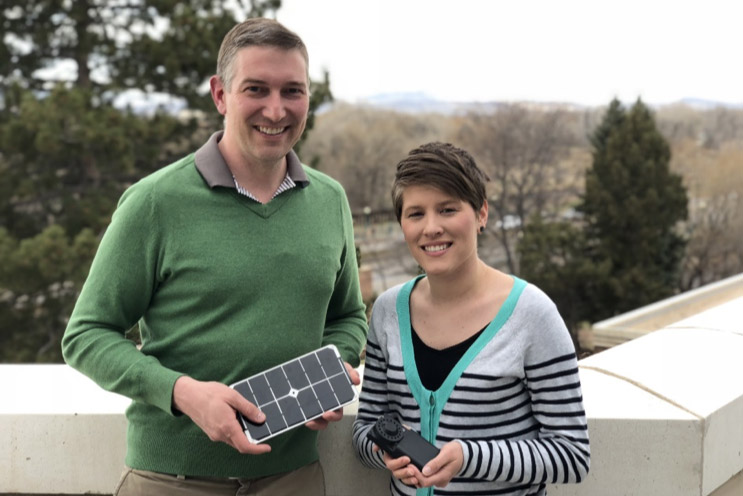
Professor John Volckens and postdoctoral fellow Jessica Tryner hold prototypes for their new air sampling technology. Photo credit: Eric Wendt
With air pollution being the fourth-leading risk factor for premature death worldwide, Colorado State University air quality experts are pushing the boundaries of air sampling technology. A Mobile Aerosol Reference Sensor, or MARS, recently blew many of its competitors away in NASA’s Earth and Space Air Challenge by being named a finalist, and earning a $50,000 award. The sensor was made in the lab of John Volckens, Energy Institute researcher and professor in mechanical engineering.
For NASA’s long-term space missions, current particulate monitoring technology couldn’t provide the level of sensitivity, longevity, or ability to operate in a reduced-gravity environment. This technology gap prompted NASA to develop the Earth and Space Air Challenge, with support from the Robert Wood Johnson Foundation. The primary goal of this effort is to improve air quality and health in space and on Earth. Applicants were encouraged to submit robust, durable, inexpensive, efficient, lightweight, and easy-to-use aerosol sensors for application in spaceflight or outdoors on Earth.
“This competition serves to catalyze the aerosol community and accelerate development of highly innovative approaches that may otherwise take years to achieve,” said Marit Meyer, research engineer at NASA’s Glenn Research Center in Cleveland, Ohio.
Vying for top prize
Using the award winnings, Volckens and postdoctoral fellow Jessica Tryner will continue developing the MARS prototype and prepare it for demonstration at the final phase of the competition at the NASA Glenn Research Center in October. There, they will compete against the remaining two finalists. The winner will receive $100,000.
“In preparation for the competition, we will spend the next several months designing components for the MARS, building prototypes, and testing the device in our laboratory and outdoors around campus,” said Tryner.
Lightweight, small, silent
Several factors put this versatile device at the forefront of air sampler technology. When used outdoors, the device will operate on solar power, allowing it to run for six months at a time. Light scattering technology will allow for reporting of particulate matter concentrations in real time, and a low maintenance internal filter will help quantify not just the concentration levels of air pollution, but the source of it, too. Additionally, the device is so lightweight, small and silent, that it can be deployed outdoors, mounted to specific locations, or worn by users.
“Solving air quality problems in spaceflight is actually very similar to solving those problems on Earth,” says Volckens. “If we can pinpoint the source of the pollution, we can develop methods to control it. The MARS device is being developed to do just that while being simple enough to operate using an app on your smartphone.”
Several industries and individuals can benefit from the MARS; from government agencies, to researchers, or everyday citizens wanting to understand air quality and how it correlates with their health. Its ease of use, precise results and low cost are all factors Volckens and Tryner prioritized.
When glancing into the future of this industry, Volckens foresees anyone being able to use this technology. “The ultimate goal of this work is help democratize the science of aerosol measurement, so that anyone, anywhere can have the power to know the quality of the air that they breathe.”